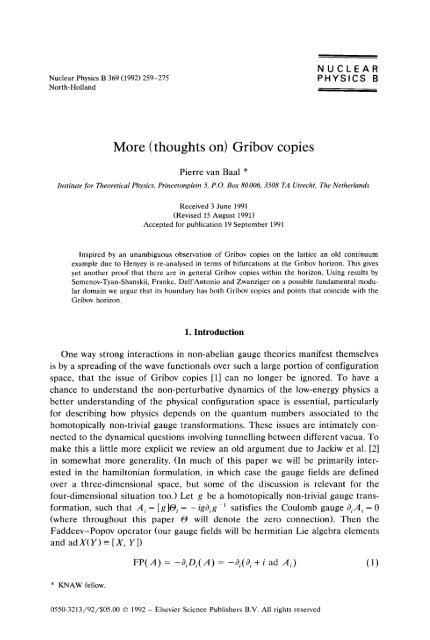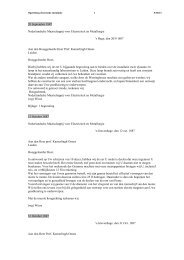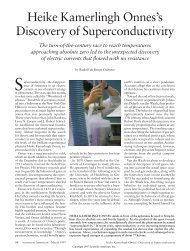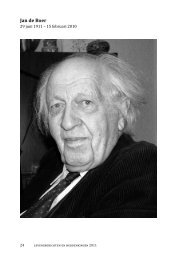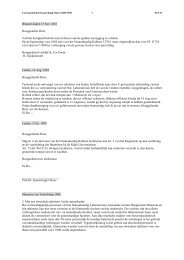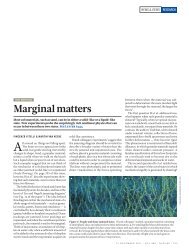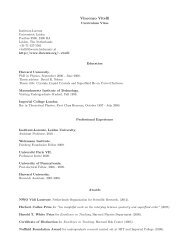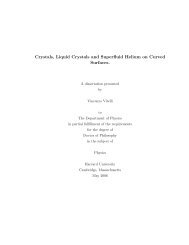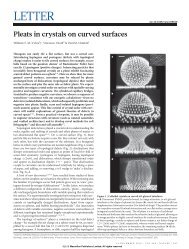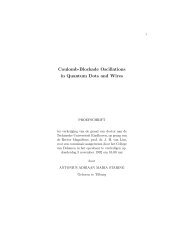Nuclear Physics B 369 (1992) - CiteSeerX
Nuclear Physics B 369 (1992) - CiteSeerX
Nuclear Physics B 369 (1992) - CiteSeerX
Create successful ePaper yourself
Turn your PDF publications into a flip-book with our unique Google optimized e-Paper software.
NUCLEAR<br />
<strong>Nuclear</strong> <strong>Physics</strong> B <strong>369</strong> (<strong>1992</strong>) 259—275 P H VS I C S B<br />
North-Holland ________________<br />
More (thoughts on) Gribov copies<br />
Pierre van Baa! *<br />
Institutefor Theoretical <strong>Physics</strong>, Princetonplein 5, P.O. Box 80006, 3508 TA Utrecht, The Netherlands<br />
Received 3 June 1991<br />
(Revised 15 August 1991)<br />
Accepted for publication 19 September 1991<br />
Inspired by an unambiguous observation of Gribov copies on the lattice an old continuum<br />
example due to Henyey is re-analysed in terms of bifurcations at the Gribov horizon. This gives<br />
yet another proof that there are in general Gribov copies within the horizon. Using results by<br />
Semenov-Tyan-Shanskii, Franke, Dell’Antonio and Zwanziger on a possible fundamental modular<br />
domain we argue that its boundary has both Gribov copies and points that coincide with the<br />
Gribov horizon.<br />
1. Introduction<br />
One way strong interactions in non-abe!ian gauge theories manifest themselves<br />
is by a spreading of the wave functiona!s over such a !arge portion of configuration<br />
space, that the issue of Gribov copies [1] can no !onger be ignored. To have a<br />
chance to understand the non-perturbative dynamics of the low-energy physics a<br />
better understanding of the physical configuration space is essentia!, particularly<br />
for describing how physics depends on the quantum numbers associated to the<br />
homotopica!ly non-trivia! gauge transformations. These issues are intimately connected<br />
to the dynamical questions invo!ving tunnelling between different vacua. To<br />
make this a !itt!e more explicit we review an o!d argument due to Jackiw et al. [21<br />
in somewhat more genera!ity. (In much of this paper we will be primarily interested<br />
in the hamiltonian formulation, in which case the gauge fields are defined<br />
over a three-dimensional space, but some of the discussion is relevant for the<br />
four-dimensional situation too.) Let g be a homotopically non-trivial gauge transformation,<br />
such that A, = = —iga,g~satisfies the Coulomb gauge 8~A,= 0<br />
(where throughout this paper 0 will denote the zero connection). Then the<br />
Faddeev—Popov operator (our gauge fields will be hermitian Lie algebra elements<br />
and adX(Y) [X, Y])<br />
* KNAW fellow.<br />
FP(A) = —0~D,(A)= —9,(c9~+ i ad A) (1)<br />
0550-3213/92/$05.OO © <strong>1992</strong> — Elsevier Science Publishers B.V. All rights reserved
260 P. van Baal / More (thoughts on) Gribov copies<br />
has a vanishing eigenvalue. The argument is simple: Constant gauge transformations<br />
leave the gauge condition invariant. The obviously related zero modes, that<br />
correspond to constant Lie algebra elements, are removed by defining the theory<br />
modulo constant gauge transformation and demanding the wave functionals to be<br />
trivial representations of the gauge group G. As g is a homotopically non-trivial<br />
gauge transformation, gXg’ cannot be constant for all constant Lie algebra<br />
elements X, but it is nevertheless a zero mode of FP(A). Thus the Gribov horizon<br />
will contain gauge copies of the classical vacuum, making it more urgent to<br />
understand the problem of gauge fixing.<br />
It seemed therefore that Gribov copies are always associated to homotopically<br />
non-trivial gauge transformations. It was first demonstrated in an example by<br />
Henyey [31that this is not always true. But probably the most simple example is<br />
provided by gauge fields on the torus in the abelian zero-momentum sector. For<br />
definiteness let us take G = SU(2) (with the Pauli matrices T~as generators of the<br />
algebra and L the size of the torus) and A, = (C 1/2L)r3, then the gauge<br />
transformation = exp(—lTixkr3/L) maps Ck to Ck + 2ir. As ~(k) is anti-periodic<br />
it is homotopically non-trivial (they are ‘t Hooft’s twisted gauge transformations<br />
[4]). However, g~)will map Ck to Ck + 4ir. As this gauge transformation is<br />
periodic and abelian, it is contractable to the identity and provides an example of<br />
gauge copies by homotopically trivial gauge transformations. This example also<br />
proves that in general there are gauge copies within the Gribov horizon, which<br />
occurs [5,6] at I Ck I = 2~. For example C = D + (—ir, 0, 0) is a gauge copy of<br />
C = D + (~r,0, 0) and both occur inside the horizon if I
P. van Baal / More (thoughts on) Grihor copies 261<br />
(almost) uniquely fix an element of the gauge orbit. In sect. 4 we make more<br />
precise in what sense this forms a fundamental modular domain. The interior is a<br />
convex subset of the transverse connections, that contains no Gribov copies. The<br />
boundary will contain Gribov copies, but can at most coincide with the horizon on<br />
a subset of the boundary of codimension one. The gauge transformations that<br />
relate the copies provides the identifications at the boundary that makes it into a<br />
fundamental modular domain for configuration space. These considerations are<br />
both relevant for the hamiltonian formulation and for the recent path integral<br />
formulation on this fundamental modular domain by Zwanziger [11], Parinello and<br />
Jona-Lasinio [12]. In the case of SU(2) gauge theory on the torus the intersection<br />
of this fundamental modular domain with the constant abelian gauge fields is given<br />
by I Ck I ~ ~ and ~(k) provides the identification of the (opposite) points on the<br />
boundary. In this case the boundary is regular, but we will argue that in general<br />
so-called singular boundary points (i.e. those that coincide with the horizon) do<br />
occur.<br />
It should be mentioned that for the torus in the presence of fields in the<br />
fundamental representation (quarks) only periodic gauge transformations are<br />
allowed. In that case it is easily seen that the intersection of the fundamental<br />
modular domain with the constant abelian gauge fields is given by the domain<br />
I Ck I ~ 2i7-, whose boundary coincides with the Gribov horizon. Nevertheless, this<br />
domain is a covering space of the domain I Ck I ~ ~ and fields in the fundamental<br />
representation can be defined on the latter if allowed to be multi-valued (an<br />
alternative formulation in terms of coordinate patches is described in ref. [6]).<br />
Later we will see that even for pure gauge theories, the wave functionals are still<br />
multi-valued, but in that case the multi-valuedness is restricted to a phase factor<br />
determined by the periodicity condition that arises as a consequence of the<br />
identifications at the boundary of the fundamental modular domain. The relevant<br />
“Bloch momenta” give the topological quantum numbers.<br />
In sect. 5 we conclude with a discussion on the implications for the hamiltonian<br />
formulation. We also re-emphasize [13] that for supersymmetric gauge theories on<br />
a torus the Gribov copies are essential for a proper evaluation of the Witten index,<br />
despite the fact that one can take the coupling constant (and hence the volume) as<br />
small as one likes. The problem remains open (despite the claim made in ref. [14])<br />
and turns out to be related to the non-trivial issue of constructing Dirac vacuum<br />
bundles that incorporate the identifications associated to the Gribov copies. It<br />
seems to require one to introduce a multi-valued vacuum wave functional that<br />
incorporates the non-conservation of chiral particle number, induced by the chiral<br />
U(1) anomaly [15]. Note that this multi-valuedness is again of a different nature as<br />
discussed in the previous paragraph (the fermions in supersymmetric gauge theories<br />
are in the adjoint representation). These issues certainly deserve further study.<br />
However, this paper will concentrate on the pure gauge sector.
262 P. van Baa! / More (thoughts on) Griboc copies<br />
2. Morse theory and bifurcation of copies at the horizon<br />
The Coulomb gauge condition ä,A<br />
1 = 0 can be formulated in terms of an action<br />
principle [8,9,16] (M is the manifold over which the gauge theory is defined, which<br />
we will mostly take three dimensional and compact. For l~l~we assume the fields to<br />
have an asymptotics that allows compactification to the three sphere.)<br />
I( g; A) I~[g]A112 = f Tr({[ g]A~} 2)= f Tr({A~+ ig ‘a~g}2), (2)<br />
M M<br />
whose critical points satisfy the gauge condition and whose hessian is precisely the<br />
Faddeev—Popov operator. This is most easily established by observing that<br />
Writing h = eX and using<br />
one finds<br />
I(hg;A)=I(h;[g]A). (3)<br />
1 —exp(—ad X)<br />
e~8 eX= (aX)<br />
adX<br />
=a,X+ ~[a 1x,X] + ~-[a1x,x], x] + ..., (4)<br />
I(eX; A) = IA 1I2_ 2if Tr(X8~A~)+ f Tr(XtFP(A)X)<br />
M M<br />
+ 1(1 X], aix]) + .... (5)<br />
We note that for gEG a constant group element I(g; A)=I(1; A), thus F~(g)<br />
defined by<br />
F~(g)=I(g; A) (6)<br />
is for generic A a Morse function [18] on .~‘/G,where ~‘ is the group of local<br />
gauge transformations, i.e. the set of functions g(x) that map M to G. (For Morse<br />
theory in relation to supersymmetric quantum mchanics, see ref. [19].) The critical<br />
points of the Morse function are precisely the gauge functions g for which [g]A is<br />
transverse (i.e. 3~[g]A~= 0.) The hessian of the Morse function at the critical point<br />
is precisely the Faddeev—Popov operator FP([g]A). The Morse index ~ for the<br />
critical points, is defined as the number of negative eigenvalues of the hessian. As<br />
FA depends continuously on A (in the norm implicitly defined in eq. (2)), the<br />
alternating sum of the Morse indices over the critical points (which is the Euler<br />
characteristic of the manifold on which FA is defined) is conserved.
P. van Baa! / More (thoughts on) Gribov copies 263<br />
This argument needs to be treated with caution, as .~‘/Gis not compact and<br />
there will in general be infinitely many critical points. Nevertheless, the property is<br />
topological in nature and is invariant under continuous deformations of FA. If we<br />
will be interested in a local neighborhood of a particular critical point, we can if<br />
necessary deform FA such that when changing A, there will only happen something<br />
to the critical points in this particular neighborhood. As the type of none of<br />
the other critical points will change, the change is finite and the alternating sum<br />
over the critical points in the chosen neighborhood will be conserved. However, in<br />
general singularities occur at reducible connections (these are connections for<br />
which there exists a non-trivial gauge function g, such that [g]A =A). Thus ~‘<br />
does not act freely and although dividing out the constant gauge transformations<br />
will remove some of the singularities, it can be shown that ~‘/G does not act freely<br />
either. Nevertheless, the presence of the remaining singularities does not affect<br />
our arguments. (For example, for SU(2) gauge theory on S<br />
3 it can be shown that<br />
up to gauge transformations A = 0 is the only reducible connection.)<br />
The Gribov region 12° is defined as the set of transverse gauge fields for which<br />
the Faddeev—Popov operator is (strictly) positive. Its boundary (312, 12 12°u 312)<br />
is the Gribov horizon, where the lowest eigenvalue vanishes. It is well known that<br />
Q0 is convex [8,17]. This is essentially because FP(A) is linear in A. Thus if A(<br />
1)<br />
and A(2) are in fl0<br />
FP(SA(I) + (1 — s)A(2)) = s FP(A(J)) + (1 — s)FP(A(2)) > 0 (7)<br />
for all s E [0, 1]. Thus, if A is on the horizon, the Morse index js(sA) will be zero<br />
for 0 ~s 1, at least in a small neighborhood of s = 1. Let us<br />
assume that as s approaches one from below, there is a sufficiently small neighborhood<br />
of the identity in ~‘/G such that Fjg) has no further extrema, except the<br />
one at g = 1. The only way the alternating sum of Morse indices can be preserved<br />
is (when s increases beyond one) if two additional extrema are created, that are<br />
both local minima, see fig. 1. Thus for s> 1 FA has extrema at g0(s) = 1, g1(s) and<br />
g2(s), where lim~1g1(s)=lim~,1g2(s)=1, such that g1121 are homotopically<br />
trivial gauge transformations. Clearly [g(12}(s)]sAE 12°and are thus points inside<br />
the Gribov horizon (inside and outside is of course well defined since U is convex)<br />
that are related by a homotopically trivial gauge transformation.<br />
Thus under the assumption that g = 1 is the only extremum of F.~ in a<br />
sufficiently small neighborhood in ~‘/G there will be a bifurcation at the horizon<br />
of solutions to the Coulomb gauge condition into two stable and one unstable<br />
solution. The assumption just mentioned, however, is easily seen to imply that the<br />
third-order term in eq. (5) has to vanish at the horizon for X the zero mode of the<br />
hessian (apart from a factor ~ this term coincides with the definition of ~.t in ref.<br />
[9]). Generically this will not be the case, in which instance there will be a saddle<br />
point that coalesces with the local minimum at the horizon and the situation is as
264 P. van Baa! / More (thoughts On) Gribov copies<br />
F~(g)<br />
~ ~ _-~ A<br />
(a)<br />
(b)<br />
(c)<br />
Fig. 1. Here we sketch the bifurcation at the horizon by three different representations. In (a) we show<br />
what happens to F~(g)when we pass the horizon (h), (b) is the well-known bifurcation picture, where s<br />
stands for stable (a local minimum) and u stands for unstable (a saddle point). Finally, in (c) we sketch<br />
the situation regarding the Gribov region.<br />
sketched in fig. 2, i.e. the saddle point with Morse index 1 will turn into a local<br />
minimum, such that the alternating sum of the Morse indices is again conserved.<br />
Note that, for s> 1 this local minimum is a homotopically trivial copy of the saddle<br />
point sA, such that the region just outside the Gribov horizon has copies just<br />
inside the Gribov horizon, which is what was already proved by Gribov [1]. In refs.<br />
[8,9] it is, however, proven that if the third-order term of eq. (5) at the horizon is<br />
non-zero for X the zero mode of the hessian, then sA for 0 © 1—s
P. van Baa! / More (thoughts on) Gribov copies 265<br />
F~(g)<br />
U<br />
~<br />
(a)<br />
Fig. 2. Here we sketch the generic situation at the horizon (h), when a (local) minimum coalesces with a<br />
saddle point.<br />
axial symmetric abelian gauge field for SU(2) gauge theory on l~,which obviously<br />
satisfies 3 1A, = 0,<br />
A=a(r,O)çbr3, ~=(—sin~,cos4,0),<br />
where (r, 0, 4) are spherical coordinates. The following gauge transformation:<br />
g = exp(a(cos ~T1 + sin c~T2)) (8)<br />
will leave the Coulomb gauge condition invariant if and only if [3]<br />
2 sin2 03,~a+ sin(2a)(2a(r, 0)r sin 8 — 1) = 0. (9)<br />
2r<br />
Rather then solving this equation for a, Henyey’s strategy was to choose a and<br />
solve for a(r, 8). He took<br />
which through eq. (9) yields<br />
a(r, 0) =b(r)r sin 8, (10)<br />
d2b(r) 4 db(r)<br />
1 b(r)+r2sin2O 2<br />
dr r dr<br />
a(r, 8) = 2r sin 0 — sin(2rb(r) sin 0) (11)
266 P. van Baa! / More (thoughts on) Gribov copies<br />
I<br />
defining a proper gauge field, provided b(r) satisfies the following three conditions<br />
[3]: (i) it is regular at the origin with vanishing first derivative (db(0)/dr = 0); (ii)<br />
2rb(r)
P. van Baa! / More (thoughts on) Gribov copies 267<br />
the relevant eigenvalue is obtained from first-order perturbation theory. With the<br />
innerproduct (X I Y) = fM Tr(X~Y)this becomes (using some partial integrations<br />
in the last step) to second order in /3<br />
/32 L~ia<br />
(X0IX0) rsin0<br />
adr 33 1X0)<br />
2 fdr dO r4b4 sin3 0(2+f(r)r2 sin2 0)<br />
p<br />
fdr dO r4b2 sin3 0<br />
(dr2b2 2<br />
fdr r2 r2b4 +<br />
2132 ), dr<br />
fdrr4b2<br />
(17)<br />
We thus confirm that A(13) always corresponds to an unstable solution to the<br />
gauge condition.<br />
It remains to show that the corresponding eigenvalues for the Gribov copies,<br />
[g(/3)]A(/3), stay positive. Explicitly we find<br />
[g(f3)]A(/3) =A~(f3)+A($),<br />
A(p) = _~{<br />
= {a(P) + sin2(/3a)( r 8 - 2a(/3))}~r3~<br />
sin(2f3a) sin(213a)<br />
2/3a D(A(p))(X~) + (i - 2/3a )x<br />
0 aln(a)}.<br />
One easily verifies that A (/3) does not contribute to second order in /3, since<br />
(18)<br />
[A(p), aX0] =0. (19)<br />
I<br />
Thus to second order in /3 the eigenvalue A’<br />
zero at /3 = 0, is given by<br />
of FP([g(/3)]A(/3)), that reduces to<br />
2<br />
p<br />
(XOIXO><br />
2Lia<br />
adr<br />
3 a<br />
rsinO<br />
X0) = —2A (20)
268 P. van Baa! / More (thoughts on) Gribov copies<br />
where we used the remarkable coincidence that (A + a<br />
sin 2(/3a)<br />
a~(f3)=a(p) ~ a~ zla=a(p=0) _21324a+O(f34). (21)<br />
We thus confirm the bifurcation picture, but in general A(f3 = 0) need not be on<br />
the Gribov horizon as FP(A(/3 = 0)) might have negative eigenvalues. To see this<br />
note that<br />
FP(A(0)) = —a~+if(r)adr 3 3~ (22)<br />
2. Thus we can decompose the eigenfunctions as<br />
commutes with ad i-3, L~and L<br />
X=X+(r)Y,m(O, ~)r~+X~(r)Y<br />
17~(O, 4)r.+X3(r)Y,,~(O,4)r3. (23)<br />
Restricted to X3 the hessian is positive definite and only the “charged” sector will<br />
be relevant, for which the hessian reduces to<br />
1 d 2~---+ d 1(1+1) r2 —2mf(r) . (24)<br />
H1~=_—~~a--r<br />
For given m and / this is a one-dimensional potential problem. It has a zero<br />
eigenvalue for I = —m = 1, with X~=b. Thus, if b has nodes there are lower (and<br />
hence negative) eigenvalues.<br />
As an example without a node, we take [3]<br />
—3 2 15r~<br />
b(r)=K(r2+r~) ~, f(r)= - 2• (25)<br />
(r~+r2)<br />
The hamiltonian (24) can only have negative eigenvalues if its potential can<br />
become negative. This only leaves (1, m) = (2, —2) and (1, — 1). As b has no nodes<br />
H 11 ~ 0, whereas H2,2 — H1 ~ 0 proves that also H2,2 ~ 0. In conclusion, eq.<br />
(25) provides an example for which A(j3 = 0) is at the Gribov horizon, which<br />
concludes this section.<br />
Let us consider the set<br />
4. The fundamental modular domain<br />
A={AIF~(g)~FÁ(1), VgE.~’}. (26)<br />
Clearly one has A a subset of 12. Furthermore, it was proven by Semenov-Tyan-<br />
Shanskii and Franke [8] and Dell’Antonio and Zwanziger [10] that A covers all
P. van Baa! / More (thoughts on) Gribov copies 269<br />
gauge orbits. That is, given a connection A (with finite norm II A II), there exists a<br />
g E ~ for which F~(g)is at its absolute minimum. The space ~ is the completion<br />
of ~‘ with respect to the norm II ~g II~2= II II 2 + IId~g112, in which 5g is<br />
viewed as a complex N x N matrix (in ref. [8] one works on ~ and a slightly<br />
different norm is used, so as to eliminate the constant gauge transformations). Let<br />
A°cA be the set where the minimum is unique, i.e. if A E A°then F~(g)> F,~(l)<br />
for all non-constant g. Both A°and A are convex [8,9], for let A( 1), A(2) E A°(A)<br />
then<br />
II[g](sA(1) + (1— s)A(2)) 112_ II sA(I) + (1 — s)A(2) 112<br />
1 2 2\ 1 2 2\<br />
=s~II[g]A(1)II — IIA(1)II + (1 —s)~II[g]A(2)II — IIA(2)II j (27)<br />
shows that sA(l) + (1 — s)A(2) E A°(A)for s E [0, 1]. Also clearly A = 0 = 0 EA°.<br />
In ref. [9] it was proved that the boundary of A°(3A°)is contained in A, and that<br />
A is closed (apply the “Frist step” lemma [9] to A°and A), which is basically a<br />
continuity argument. Alternatively, take A E A — A°,and use eq. (27) for A(I) = 0<br />
and A(2) =A, which implies that sA EA° for all s, 0 ~ s < 1 and hence A E r9A 0.<br />
Thus the boundary still exists of transverse gauge fields A such that F~(g)reaches<br />
its absolute minimum at g = 1, but this minimum need not be unique or might be<br />
on the Gribov horizon.<br />
To analyse these two options, take A E U — A, then the ray sA will cross the<br />
boundary of A where necessarily an absolute minimum turns into a relative<br />
minimum. At the boundary F~(g)therefore has degenerate absolute minima, that<br />
are related by in general large gauge transformations. We will call these points on<br />
3A regular boundary points. The remaining points of the boundary will necessarily<br />
be on the Gribov horizon and are called singular boundary points. That the set of<br />
regular boundary points is non-empty is easily established by taking the example of<br />
A = [g]0 for g homotopically non-trivial, such that A is on the Gribov horizon.<br />
The path sA will pass 3A at (necessarily) a regular point (as the absolute minimum<br />
of FA does not occur at constant gauge functions, but at g ~, where it vanishes).<br />
The gauge transformation that relates the two copies at the boundary of A is<br />
essentially g and is thus homotopically non-trivial (as mentioned before, in the<br />
torus example the fundamental modular domain restricted to the abelian constant<br />
modes is given by I Ck I ~ ~ modulo the action of the Weyl group C —p — C and all<br />
boundary points are easily seen to be regular [5,6]). Strictly speaking therefore,<br />
also A is not a fundamental modular domain. Yet it will be, once we have<br />
appropriately identified the boundary points. It is these boundary identifications<br />
that will give the fundamental modular domain the topology of the full configuration<br />
space which is the basis of Singer’s [20] argument why for gauge theories on a<br />
compact three- or four-dimensional manifold M, there necessarily have to be<br />
gauge copies.
270 P. van Baal / More (thoughts on) Gribov copies<br />
Observe that homotopical non-trivial gauge transformations are in one-to-one<br />
correspondence with non-contractable loops in configuration space, which give rise<br />
to conserved quantum numbers. The quantum numbers are like the Bloch momenta<br />
in a periodic potential and have to be representations of the homotopy<br />
group of gauge transformations. On the fundamental modular domain the noncontractable<br />
loops arise through identifications of boundary points (as is quite<br />
explicit for the torus in the zero-momentum sector). Although slightly more<br />
hidden, the fundamental modular domain will therefore contain all the information<br />
relevant for the topological quantum numbers (i.e. it does not have to be “put<br />
in by hand”). Sufficient accurate knowledge of the boundary identifications will<br />
allow, however, for an efficient and natural projection on the various superselection<br />
sectors (i.e. by choosing the appropriate “Bloch wave functionals”). All these<br />
features were at the heart of the finite-volume analysis on the torus [5] and we see<br />
that they can in principle naturally be extended to the full theory, thereby<br />
including the desired 0-dependence. In ref. [6] we proposed formulating the<br />
hamiltonian theory on coordinate patches with homotopically non-trivial gauge<br />
transformations as transition functions. We can shrink these patches almost to A<br />
(and their associated gauge copies, with the homotopically non-trivial gauge<br />
transformations that relate the inequivalent classical vacua). If there would be no<br />
singular boundary points we would avoid any points on the Gribov horizon,<br />
thereby defining open sets that do cover the whole configuration space. These two<br />
formulations are therefore equivalent.<br />
However, it is essential to note that the topology of the configuration space is<br />
not described entirely by non-contractable loops. One also needs to consider<br />
non-contractable spheres of any dimension. It is the non-contractable spheres that<br />
in general will be responsible for singular boundary points in the fundamental<br />
modular domain. As the interior is convex, non-contractable d-spheres can only<br />
arise if the boundary contains a (d — 1)-sphere on which all points are identified.<br />
These correspond to gauge orbits for which FA is degenerate along this (d — 1)sphere<br />
embedded in ~‘. Thus, these A necessarily coincide with the horizon. One<br />
can introduce a regular coordinate patche in the neighborhood of these singular<br />
points to eliminate the singularities, as observed by Singer and Nahm [20,21]. In<br />
this case, though, transition functions can not be described in terms of gauge<br />
transformations [6]. For example, when G = SU(2) these non-contractable spheres<br />
do actually occur [20].Thus it seems that we cannot avoid singular boundary points<br />
(as was suggested by fig. 1 of ref. [11]). We do not claim that our arguments<br />
present a proof for the existence of singular boundary points, as we implicitly<br />
assumed that the topology of configuration space is unaffected by the completion<br />
with respect to the norm II A II. These issues can be quite intricate, as for example<br />
the winding number of a C’ gauge transformation, when defined through<br />
v(g)= 24~2fMTr(~ dg) 3), (28)
P. van Baa! / More (thoughts on) Gribov copies 271<br />
is not continuous in the norm II 6g II,. However, continuity is sufficient to define<br />
homotopy types. Relevant for this issue is the Sobolev embedding theorem<br />
W~c Ck for k 1, m ~ 1 are<br />
guaranteed to be continuous (as can be easily deduced explicitly by using Holder’s<br />
inequality). In the present case n = 3, m = 1 and p = 2, which unfortunately does<br />
not imply continuity. Indeed, for example, one can construct a series of maps<br />
g~:S~ SU(2) —~ SU(2) that for all n have winding number zero but converges in<br />
the norm II 5g II to the identity map with winding number one. Yet, one must<br />
remember that the gauge fields in the fundamental modular domain satisfy the<br />
Coulomb condition (in the weak sense) from which one might deduce stronger<br />
smoothness properties. Thus, it is possible that using more sophisticated results<br />
from functional analysis will allow one to make stronger claims than we are willing<br />
to commit ourselves to here. One should address these issues primarily in the light<br />
of the physically more relevant dynamical questions and in that context we<br />
certainly intend to come back to this in the future.<br />
In conclusion, it might be that the “hole” in configuration space, due to a<br />
non-contractable loop or sphere, is of zero size in the norm II A II. We consider<br />
this unlikely, but cannot exclude it. Actually, it might be the mechanism through<br />
which lattice gauge theories in the continuum limit reproduce the various topological<br />
sectors associated with the winding numbers. By this we mean that by<br />
demanding the fields to be “smooth”, we will “cut” the necessary holes in<br />
configuration space. This requires an appropriate understanding of what it means<br />
to take the continuum limit, for which the “dislocations” [23] play an important<br />
role. Concerning gauge fixing in lattice gauge theory we only wish to remark that<br />
one can similarly impose a Coulomb (or Landau) type gauge through an action<br />
principle [24]. Our statement that A requires identifications at the boundary is<br />
equally valid in this case. Also one has to realize that, although there are no<br />
homotopically non-trivial gauge transformations associated with the winding number,<br />
twisted gauge transformations [4] are still well defined and cannot be deformed<br />
to the identity.<br />
5. Discussion<br />
We have reconsidered the proposed [8,10—12]fundamental modular domain A<br />
consisting of the absolute minima of the norm II[g]A II on a gauge orbit and shown<br />
it is a fundamental modular domain provided necessary gauge identifications at the<br />
boundary are taken into account. As these identifications determine uniquely the<br />
topology of the configuration space, it can be argued, due to the presence of
272 P. van Baa! / More (thoughts on) Gribov copies<br />
non-contractable spheres in the configuration space (this is true both for threeand<br />
four-dimensional compact manifolds M over which the gauge theory is<br />
defined) that in general there will be so-called singular boundary points, on which<br />
the Faddeev—Popov determinant will vanish. One can still attempt to formulate<br />
the standard hamiltonian [25]on this fundamental modular domain. Usually one<br />
rescales the wave functional with i~(FP(A)) which will be strictly positive<br />
everywhere, expect at a subset of the boundary to the fundamental modular<br />
domain of codimension 1, where its vanishing is associated to a coordinate<br />
singularity due to a non-contractable sphere in configuration space. As topological<br />
quantum numbers are only associated to non-contractable loops, it might be that it<br />
is sufficient to simply demand the (resealed) wave functional to vanish at the<br />
singular boundary points. This requires further study as subtle effects can complicate<br />
the issue, especially in the presence of fermions. We only need to remind the<br />
reader of the global SU(2) anomaly [26],which on a three-dimensional manifold M<br />
will be associated with a two-dimensional non-contractable sphere in configuration<br />
space. In this context we can recommend ref. [27] for a clear description of the<br />
issue of anomalies in the hamiltonian formulation.<br />
The issue of gauge copies has played an important role in the analysis of the<br />
spectrum of the low-energy states for SU(2) gauge theory on the torus in a finite<br />
volume. As was mentioned before, in the sector of the abelian constant modes<br />
Ak = (Ck/2L)T 3, which forms the “vacuum or toron valley” along which the<br />
classical energy vanishes, A is described by I Ck I ~ ~. The gauge transformation<br />
that maps Ck = —~rto Ck = iT is given by g(k) = exp(—irii-3xk/L), which<br />
due to its anti-periodicity is homotopically non-trivial and provides the required<br />
boundary identifications. In this subsector all boundary points are easily seen to be<br />
regular. The “Bloch momenta” label ‘t Hooft’s electric flux quantum numbers [4]<br />
1If(C~= —ir) = exp(irie~)hII(Ck = ~r). Note that the phase factor is not arbitrary,<br />
but ±1. This is because g~%,~1is homotopically trivial. It thus looks like as if we have<br />
to put the topological structure in by hand after all, however, one should realize<br />
that considering a slice of A will obscure some of the topological features. A loop<br />
that winds around the slice twice is contractable in A as soon as it is allowed to<br />
leave the slice. Indeed including the lowest modes transverse to this slice will make<br />
the ~2 nature of the relevant homotopy group evident [5,6]. It shows that not<br />
dynamically motivated truncations can obscure things. For example, a recent<br />
reduction to spherically symmetric gauge fields [28] is only of limited value if the<br />
non-spherical fluctuations (which can in principle lead to Gribov horizons) are not<br />
taken into account.<br />
In weak coupling Lüscher [29] showed unambiguously that the wave functionals<br />
are localized around A = 0, that they are normalizable and that the spectrum is<br />
discrete. In this limit the spectrum is insensitive to the boundary identifications<br />
(giving rise to a degeneracy in the topological quantum numbers). At stronger<br />
coupling the wave functional spreads out over the vacuum valley and the boundary
P. van Baa! / More (thoughts on) Gribov copies 273<br />
conditions drastically change the spectrum [5]. In supersymmetric gauge theory the<br />
situation is even more dramatic. In the bosonic case, what localizes the wave<br />
functional in weak coupling is an induced potential barrier due to the zero-point<br />
fluctuations of the modes transverse to the vacuum valley. Due to the supersymmetry<br />
this induced barrier is expected to be canceled exactly by the fermionic<br />
contribution and the wave functional is expected to spread out over the whole<br />
vacuum valley. The problem is, however, that transverse fluctuations become<br />
singular near A = 0, preventing a reduction to the vacuum valley. As in the bosonic<br />
sector one can hope that a truncation to the zero-momentum sector will be<br />
possible, but as the wave functional is expected to spread out over the vacuum<br />
valley and as the gauge copies that thus arise will bring one outside of the<br />
zero-momentum sector, this would not be a consistent truncation either. Indeed, it<br />
was rigorously proven in ref. [13] that the spectrum of the zero-momentum<br />
Yang—Mills hamiltonian is continuous down to zero energy. Apart from the fact<br />
that such a continuous spectrum would make the Witten index ill defined, it is not<br />
compatible with the fact that the theory was originally defined in a finite volume.<br />
We consider this as a strong indication for the spreading of the wave functional<br />
beyond the Gribov copies. The appropriate identifications due to these copies<br />
should lead to the desired discrete spectrum. In the bosonic sector there is a<br />
dynamical reduction to a finite number of degrees of freedom [5,6]. But in the<br />
fermionic sector it requires one to construct vacuum Dirac bundles that incorporate<br />
the identifications at the boundary of the fundamental modular domain. Our<br />
problem is, that this does not seem to allow for a dynamical reduction to a finite<br />
number of degrees of freedom. As the results of ref. [14] rely on the truncation to<br />
the zero-momentum sector, without addressing the Gribov copy problem, we do<br />
not understand how the results in that paper can solve the problem of constructing<br />
the zero-energy states (unfortunately the construction of the wave function in ref.<br />
[14] is rather implicit and incomplete, which makes it hard to pin down exactly<br />
what might make it unsuitable as a zero-energy ground-state wave function). Thus<br />
it will remain an interesting and unfortunately open problem, whose solution will<br />
shed light on the discrepancy between the naive Witten index calculation [30] on<br />
the torus for 0(N) (N> 6) (giving an index equal to the rank of 0(N) plus one)<br />
and the value deduced from the gluino condensate calculations in an infinite<br />
volume [31] (yielding the value N — 2). When it persists, this would imply that the<br />
Witten index in this case will have discontinuities, which will have interesting<br />
consequences for the non-perturbative vacuum in these theories.<br />
I thank Daniel Zwanziger for sending me ref. [10] and Maarten Golterman,<br />
Han Dass, Andreas Kronfeld, Morton Laursen, Peter Lepage, Jeff Mandula, Paul<br />
Mackenzie, Michael Ogilvie, Stepen Sharpe, Jan Smit, Arjan van der Sijs and Jac<br />
Verbaarschot for discussions on Gribov copies and horizons at various occasions. I<br />
also thank Bernard de Wit, Hiroshi Itoyama, Bob Razzaghe-Ashrafi, Arkadi
274 P. van Baa! / More (thoughts on) Gribov copies<br />
Vainshtein and in particular Mikhail Shifman for discussions on the Witten index<br />
calculation on the torus. I am grateful to Karl Isler for his insights about the Dirac<br />
vacuum bundles.<br />
Many useful comments on the manuscript and during seminars have helped me<br />
to clarify a number of issues, for which I thank Sidney Coleman, Jan de Boer,<br />
Philippe de Forcrand, Jim Hetrick, Key-Fei Liu, Herman Verlinde and Daniel<br />
Zwanziger. I am grateful to the Cern Theory Division for their hospitality during<br />
my visit in July. This research has been made possible by a fellowship of the Royal<br />
Netherlands Academy of Arts and Sciences.<br />
References<br />
[11 V. Gribov, Nucl. Phys. B139 (1978) 1<br />
[2] R. Jackiw, I. Muzinich and C. Rebbi, Phys. Rev. D17 (1978) 1576<br />
[31 F.S. Henyey, Phys. Rev. D20 (1979) 1460<br />
[41 G. ‘t Hooft, NucI. Phys. B153 (1979) 141<br />
[5] J. Koller and P. van Baal, NucI. Phys. B302 (1988) 1<br />
[61 P. van Baal, in Probabilistic methods in quantum field theory and quantum gravity ed. PH.<br />
Damgaard et al. (Plenum, New York, 1990) p. 131; in Frontiers in non-perturbative field theory,<br />
ed. Z. Horvath et al. (World Scientific, Singapore, 1989) p. 204<br />
[71Ph. de Forcrand et al., NucI. Phys. B (Proc. Suppl.) 20 (1991) 194<br />
[8] MA. Semenov-Tyan-Shanskii and V.A. Franke, Zapiski Nauchnykh Seminarov Leningradskogo<br />
Otdeleniya Matematicheskogo Instituta im. V.A. Steklov AN SSSR, 120 (1982) 159 [Translation:<br />
(Plenum, New York, 1986) p. 19991<br />
[91 0. Dell’Antonio and D. Zwanziger, in Probabilistic methods in quantum field theory and quantum<br />
gravity, ed. PH. Damgaard et al. (Plenum, New York, 1990) p. 107<br />
[101 0. Dell’Antonio and D. Zwanziger, Commun. Math. Phys. 138 (1991) 291<br />
[111 D. Zwanziger, NucI. Phys. B345 (1990) 461<br />
[121 C. Parinello and 0. Jona-Lasinio, Phys. Lett. B251 (1990) 175<br />
[131 B. de Wit, M. Lüscher and H. Nicolai, NucI. Phys. B320 (1989) 135<br />
[141 H. Itoyama and B. Razzaghe-Ashrafi, NucI. Phys. B354 (1991) 85<br />
[151G. ‘t Hooft, Phys. Rev. Lett. 37 (1976) 8; Phys. Rev. D14 (1976) 3432<br />
[161 K. Wilson, in Recent developments in gauge theories, ed. G.’t Hooft et al. (Plenum, New York,<br />
1980) p. 363;<br />
G. ‘t Hooft, NucI. Phys. B190 [FS3] (1981) 455<br />
[171 D. Zwanziger, Phys. Lett. B114 (1982) 337; NucI. Phys. B209 (1982) 336<br />
[18] J. Milnor, Morse theory, Ann. Math. Stud. 51 (Princeton Univ. Press, Princeton NJ, 1973)<br />
[19] E. Witten, J. Diff. Geom. 17 (1982) 661;<br />
P. van Baal, Acta Phys. Pol. B21 (1990) 73<br />
[201 I. Singer, Commun. Math. Phys. 60 (1978) 7<br />
[211 W. Nahm, in Proc. IV Warsaw Symp. on Elementary particle physics, ed. Z. Ajduk (Warsaw, 1981)<br />
p. 275<br />
[22] Y. Choquet-Bruhat et al., Analysis, manifolds and physics (North-Holland, Amsterdam, 1977) p.<br />
412<br />
[23] D.J.R. Pugh and M. Teper, Phys. Lett. B224 (1989) 159<br />
[24] J. Mandula and M. Ogilvie, Phys. Lett. B185 (1987) 127<br />
[251 N.M. Christ and T.D. Lee, Phys. Rev. D22 (1980) 939<br />
[261 E. Witten, Phys. Lett. B117 (1982) 324<br />
[27] P. Nelson and L. Alvarez-Gaumé, Commun. Math. Phys. 99 (1985) 103
P. van Baa! / More (thoughts on) Gribov copies 275<br />
[28] D. SchOtte, The problem of gauge fixing for spherically symmetric Yang—Mills fields, Bonn<br />
preprint (April 1991)<br />
[29] M. LOscher, NucI. Phys. B219 (1983) 233;<br />
M. LOscher and G. MOnster, NucI. Phys. B232 (1984) 445<br />
[30] E. Witten, NucI. Phys. B202 (1982) 253<br />
[31] M. Shifman and A. Vainshtein, NucI. Phys. B296 (1988) 455


